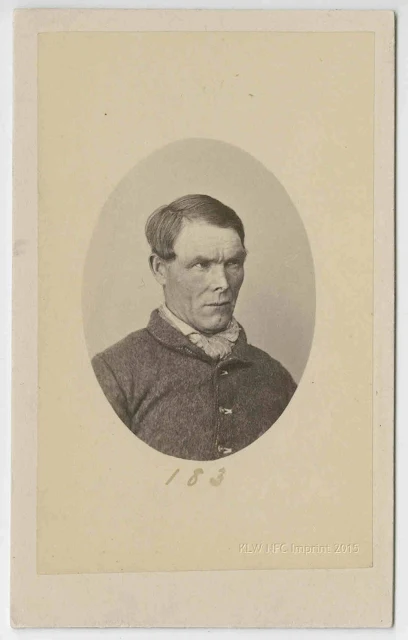Photographer T. J. NEVIN at the MPO 1874 and Hobart Gaol 1875
Crimean shirts, photos by J. Bishop-Osborne
The TMAG copy
The verso of this cdv of Albert Doran bears his name - or rather his incorrectly transcribed alias - the ship on which he was transported to Van Diemen's Land (Tasmania), the inscription - "Taken at Port Arthur 1874" - and the number "35" . This information was inscribed by photographer and collector John Watt Beattie with his assistant Edward Searle in the early 1900s for the tourist market despite their provenance as official police documents. The number "35" on the verso of this cdv also appears on the bottom right of Beattie's sepia reprint from Nevin's original negative, inscribed by Beattie when preparing the print to be pasted to one of three panels he offered for sale in 1916 at his "Port Arthur Museum" located at 51 Murray St. Hobart (see below). This cdv, together with another 300 or so Tasmanian mugshots, was accessioned at the QVMAG Launceston from Beattie's estate on his death in the 1930s.
Between February and April 1983, five dozen or more cdv's from Beattie's collection of mugshots held at the QVMAG in Launceston were removed and exhibited at the Port Arthur prison site south of Hobart for the Port Arthur Conservation and Development Project (PACDP). To keep track of them, each was numbered in pencil on the front mount underneath the prisoner's image. Those numbers do not correspond to the original numbers written on the versos by Beattie in the early 1900s. After the exhibition, fifty (50) or so of those cdv's exhibited at Port Arthur in 1983 were not reinstated in Beattie's collection at the QVMAG, they were deposited instead at the TMAG in Hobart. An inventory of 200 mugshots drawn up in the 1980s at the QVMAG with these new numbers recto showed 127 were missing, dispersed to national and state libraries, museums and even publishers, and 72 were remaining. Albert Doran's mugshot, numbered "21" on the mount in the removal to Port Arthur and relocation to the TMAG in Hobart, was among those missing.The QVMAG inventory list can be viewed here.
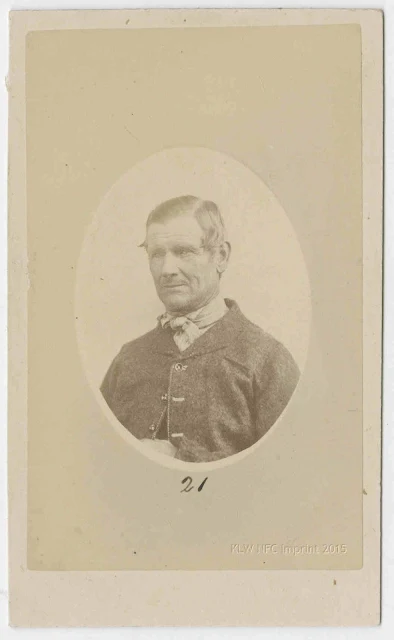

Prisoner DORAN, Alfred [sic - registered by police as Albert Frederick DORAN, transported as Archibald Dorman, arrested as Alfred Dorman, Dormian and Albert Doran.
Source: TMAG Ref: Q15580
Albert Doran was transferred from Launceston to the Hobart Gaol on 29 Dec 1873. He was photographed by Thomas J. Nevin at the Police Office Hobart on 18 February 1874 when he was arrested for escaping from a gang at the Cascades Reservoir. Within days, on 22 February 1874, he was sent to the Port Arthur prison, 50 kms south of Hobart. He was transferred back to the Hobart Gaol - the Hobart House of Corrections - on 9 March 1875 when Nevin would have printed more duplicates of his cdv to be pasted to Doran's rap sheet. Unfortunately, these rap sheets from the 1870s seem not to have survived. This information is taken from the conduct record below:

Albert Doran as Archibald Dorman and McQueen
Tried Launceston Court 17 Sept 1872 Four years imprisonment with hard labor
Removed to Hobart Town 29 Dec 1873
PO Hobart Town 18.2.74 Escaping 6 months imprisonment with hard labor
Received again at Port Arthur 22 Feb 1874
Transferred to the Hobart House of Corrections 9 March 1875
Link: https://libraries.tas.gov.au/Digital/CON94-1-2/CON94-1-2P61
The QVMAG copies
Albert Doran's photograph in this panel is top row first on left. It is one of three panels with 40 uncut sepia mugshots which John Watt Beattie offered for sale at his convictaria museum, Hobart, from his 1916 catalogue.

QVMAG Collection: Ref : 1983_p_0163-0176 (one of three panels)

The photograph (above) is an unmounted sepia print from the negative of Thomas J. Nevin’s sitting with Albert Doran taken at the MPO 18 February 1874. It is held at the Queen Victoria Museum and Art Gallery. In the early 1900s John Watt Beattie salvaged this unmounted print from the Hobart Gaol records for display at his "Port Arthur Museum" located in Murray Street Hobart, and for inclusion in intercolonial travelling exhibitions of convictaria associated with the fake convict hulk, Success, Hobart Adelaide, and Sydney. Beattie pasted this print on one of three panels of 40 sepia uncut prints of Tasmanian prisoners sourced from the Hobart Gaol Sherriff's Office and the Municipal Police Office, Town Hall, removing them from prisoners' rap sheets and the police "Photo Books" of mugshots. He offered the three panels for sale in his 1916 Catalogue. The number "35" visible in reverse at bottom right of the print was inscribed by Beattie for numbering the print and the cdv he produced for display and sale as tourist souvenirs.
Original glass plate negatives by T. J. Nevin 1870s
Reprints by J. W. Beattie ca. 1915
QVMAG Collection: Ref : 1983_p_0163-0176

"Unknown" convict at the QVMAG. Ref: QVM: 1985:P: 200151
Link: https://collection.qvmag.tas.gov.au/fmi/webd/QVMAGweb
Albert Doran's photograph, as one of the 40 mugshots pasted to three panels and offered for sale by Beattie in 1916, was reprinted in black and white from Beattie's reprint of Nevin's original sepia negative in 1985 by Chris Long during a short "residency" at the QVMAG. He fogged out cracks, dirt and scratches in the process for reasons known only to himself since they serve no apparent purpose. The prisoner, however, was not identified as Albert Doran at the QVMAG because the carte-de-visite print in an oval mount of this same capture (e.g. the TMAG cdv above) which was inscribed with his name and ship verso in the early 1900s had been removed from the QVMAG in 1983 for exhibition at the Port Arthur Heritage site. He was therefore listed as "Unknown" when put online in the 2000s (QVMAG. Ref: QVM: 1985:P: 200151).
The Archives Office Tasmania copy
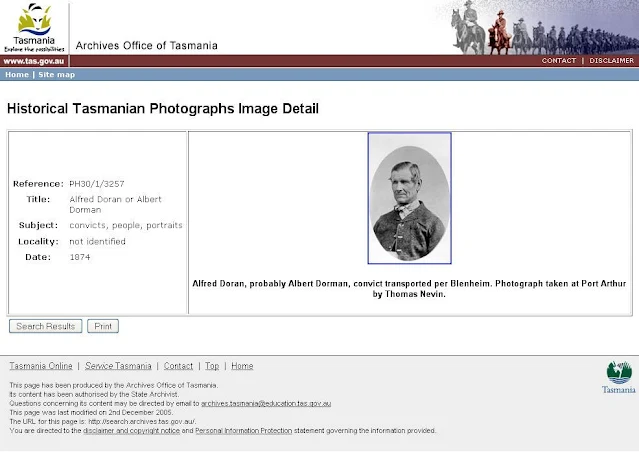
Archives Office of Tasmania webshot 2005
Reference: PH30/1/3257
Title: Alfred Doran or Albert Dorman
Caption: Alfred Doran, probably Albert Dorman, convict transported per Blenheim. Photograph taken at Port Arthur by Thomas Nevin.
DUPLICATE or COPY?
This mounted cdv of Albert Doran now held at the Archives Office Tasmania is either a duplicate made by Nevin from his original in 1874 (he produced 4 prints from his negative at the one sitting with the prisoner) or a poor copy of the cdv now held at the TMAG (see above). As a copy it was most likely sourced as an estray from Radcliffe's tourist attraction at Port Arthur (by then called Carnavon) in the 1930s called "The Old Curiosity Shop" where he displayed convictaria originally sourced from Beattie's collections.

Archives Office of Tasmania APA citation 2013:
"Alfred Doran, probably Albert Dorman, convict transported per Blenheim. Photograph taken at Port Arthur by Thomas Nevin. LINC Tasmania"BDM details: Albert DORAN
ARRIVAL VDL (Hobart) 1851 as Archibald Dorman, Alfred Dorman https://libraries.tas.gov.au/Record/NamesIndex/1388173
Dorman, Albert
Record Type: Convicts
Departure date: 29 Jul 1851
Departure port: Cork
Ship: Blenheim (4)
Place of origin: Down
Remarks: Transported as Archibald Dorman
Conviction: Larceny of plate, transported for 7 years per Blenheim 4
Source: https://libraries.tas.gov.au/Digital/CON33-1-104/CON33-1-104P84

Transportation record, listed as Archibald Dorman, labourer, 24 years old
LInk: https://libraries.tas.gov.au/Digital/CON33-1-104/CON33-1-104P84
CONDUCT 1857 -Albert Dorman
Link: https://libraries.tas.gov.au/Record/NamesIndex/1502869
Link: https://libraries.tas.gov.au/Digital/CON94-1-2/CON94-1-2P61
CHILDREN with Bridget Kenny
Link: https://libraries.tas.gov.au/Record/NamesIndex/964845
Link: https://libraries.tas.gov.au/Record/NamesIndex/968990 [and more etc etc]
DEATH 21 November 1890 New Town Charitable Inst 66 yrs old
Link: https://libraries.tas.gov.au/Digital/RGD35-1-13/RGD35-1-13P6
Police Gazette and Court Records
Sources: The Archives Office of Tasmania for original documents. Additional information from the weekly police gazettes, Tasmania Reports of Crime for Police, J. Barnard, Gov't printer, and court records with links from the Prosecution Project, Griffith University from Archives Office of Tasmania records.
Link: https://libraries.tas.gov.au/Record/NamesIndex/1388173;
Link: https://app.prosecutionproject.griffith.edu.au/web/public-search/search
1857: larceny
Larceny, sentenced to 2 yrs HM Gaol with hard labor
https://libraries.tas.gov.au/Record/NamesIndex/1502869
Name: Dorman, Albert
Record Type: Court
Status: Free by servitude
Trial date: 23 Jul 1857
Place of trial: Oatlands
Offense: Stealing 1 pair of candlesticks value: 20/- and other articles the property of daniel brown
Verdict: Guilty
1863: housebreaking
Larceny 1863 housebreaking with Bridget Doran
Link: https://libraries.tas.gov.au/Digital/SC32-1-8/SC32-1-8_223
106576 ALBERT DORAN MALE HOUSEBREAKING AND STEALING 1863-07-29 HOBART TOWN SMITH NOT GUILTY Link 1 and Link 2
1864: discharged
Discharged 1864 by proclamation
Link: https://libraries.tas.gov.au/Digital/SC32-1-8/SC32-1-8_252
106780 ALBERT DORAN MALE LARCENY 1864-06-01 HOBART TOWN SMITH DISCHARGED BY PROCLAMATION Link 1 and Link 2
The reason for Albert Doran's discharge by proclamation probably came down to a lack of evidence or witnesses. This episode in 1861 prompted the reporter to query discharge by proclamation:
DISCHARGED BY PROCLAMATION. Our readers know that when a prisoner has been "committed" to take his trial it not unfrequently happens, or rather it too frequently happens, that the grand jury of the colony, the Attorney-General, declines to file a bill of indictment. In that case when the court is in session the crier at the command of the judge begins, "0yez, 0yez, 0yer," and invites all and sundry who know of treason, felonies, &c., against the prisoner, to come forward and prosecute, and the functionary then informs all and sundry that if they will not or cannot do so, the prisoner will be discharged, and discharged he is. At the last sessions of the Supreme Court, this operation was performed in the case of two individuals charged with housebreaking, brought home to them by the clearest and most conclusive evidence. A witness saw part of the property identified, in the dwelling of the prisoners. Another witness saw them jointly planting property on the north side of the Cataract. The police were informed of this, and two detectives discovered the articles. They also found a counterpane belonging to the prosecutor on the bed of the prisoners. The male prisoner was seen in the plundered dwelling on the day of the robbery. Now why were not these persons left to the disposal of a jury ? Why were they discharged by proclamation ? We ask on public grounds and in the interests of justice to society -Can any satisfactory explanation be given ? We fear not.Source: Launceston Examiner (Tas. : 1842 - 1899), Tuesday 22 January 1861, page 2
1872: larceny
Larceny, tried Launceston, 4 yrs imprisonment
https://libraries.tas.gov.au/Digital/ab693-1-1/ab693-1-1_101
He was charged with stealing a gun and spoons.
112579 ALBERT DORAN MALE LARCENY 1872 08-24 GUILTY4 YEARS Link 1
1874: absconding
Absconding 1874, served 6 months
Link: https://libraries.tas.gov.au/Digital/AB693-1-1/AB693-1-1_101
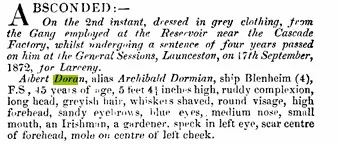
Albert Doran, alias Archibald Dormian ship Blenheim (4), warrant for absconding, published in the police gazette, 6 February 1874:
TRANSCRIPT
ABSCONDEDWarrant for Albert Dorian 6 Feb 1874; arrest on 20 Feb 1874.
On the 2nd instant, dressed in grey clothing, from the Gang employed at the Reservoir near the Cascade factory, whilst undergoing a sentence of four years passed on him at the General Sessions, Launceston, on 17th September 1872 for Larceny.
Albert Doran, alias Archibald Dormian, ship Blenheim (4), F.S., 45 years of age, 5 feet 4½ inches high, ruddy complexion, long head, greyish hair, whiskers shaved, round visage. high forehead, sandy eyebrows, blue eyes, medium nose, small mouth, an Irishman, a gardener, speck in left eye, scar centre of forehead, mole on centre of left cheek.

Albert Doran was arrested on 20 February 1874 by the Oatlands Municipal Police. He absconded from this reservoir, photographed by Thomas Nevin's friend and business partner Samuel Clifford in the 1860s:

Description: Photograph - Mt Wellington from the Cascade Brewery Reservoir, photographer Samuel Clifford, Liverpool Street, Hobart
Item Number: LPIC147/5/159
Start Date: 01 Jan 1860 End Date: 31 Dec 1869
Source:Tasmanian Archives
Link:https://libraries.tas.gov.au/Record/Archives/LPIC147-5-159

Storage reservoir, H.T. waterworks Clifford photo.
Author/Creator: Clifford, Samuel, 1827-1890.
Publication Information: 1867.
Physical description: 1 photograph : sepia toned ; 8 x 8 cm.
Notes: Title printed on label and pasted below image.
Inscribed below image lower left in ink: Clifford photo. ; right: 1867.
For descriptive notes by Alfred Abbott see his notebook item 192.
In: Abbott album Item 112
Citation: Digitised item from: W L Crowther Library, State Library of Tasmania.
Link: https://libraries.tas.gov.au/Record/Library/SD_ILS-136580
1877: discharged
Albert Doran, using the alias William Hales, was charged with stealing two silver spoons.

Albert Doran, 50 yrs old also known to police as Dorman or Dorman, per Blenheim 4 was discharged from the Hobart Gaol on 21 February 1877 from sentencing of 4 yrs in Sept 1872 and absconding for 6 months from a gang in 1874.
1878: assault and rape
Assault and rape 1878 - ignored together with John Hall
Link: https://libraries.tas.gov.au/Digital/AB693-1-1/AB693-1-1_117
The charge was "ignored" - what was the meaning then? Was it was dropped by the complainant?
117738 ALBERT DORAN MALE ASSAULT AND RAPE 1878-06-21 IGNORED Link 1
1879: fraud

TRANSCRIPT
The Crimean shirts obtained from Mr. W. J. Jarvis have been recovered by D. C. McMurray, of the Hobart Territorial Police, and Albert Frederick Doran convicted of the offence.Albert Doran was convicted of obtaining five Crimean shirts from Jarvis's drapery Murray by fraudulent means, sentenced to three months.
The CRIMEAN SHIRT
As told by Google AI:
The "Crimean shirt" is so named because it was a style of shirt commonly worn by soldiers during the Crimean War (1853-1856). It was typically a wide, collared, V-necked shirt, often made of flannel, and usually without buttons. It often came in solid colors like red or blue, and was frequently worn with a sash or belt around the waist. The design allowed for ease of movement, and the sleeves were often rolled up during work, making it a practical choice for soldiers and laborers. The shirt's popularity extended beyond the Crimean War, becoming a common piece of clothing for bushmen, stockmen, and miners in Australia, especially from the 1860s onward.The Crimean War also gave rise to other clothing items, including the cardigan and balaclava hood, reflecting the need for warm clothing during the conflict.Commercial photographer John Bishop-Osborne was active in Tasmania in the years 1879-1894. The posed tableau (below) of rugged and relaxed masculinity may have been at the request of a local tobacconist wishing to advertise his stock and wares. The message: smoking pleasure awaits working-class men of the bush if they were to indulge in a certain brand of tobacco and pipe, a pleasure enhanced no doubt by wearing a Crimean shirt in a choice of styles.
Modelled here are four styles: two men wear the short sleeve collarless style with a V-neck - one standing centre, the other seated on left in a darker colour. The man seated at centre wears the long-sleeve collarless button-to-the neck style, and the man standing to the right wears a dark - possibly red - long-sleeve style open to the waist with a full collar. The man reclining, pointing to the future, wears a short sleeve button-to-the neck style. Bishop-Osborne was favoured for his portaits of actors and celebrities. His five models for this tableau may have been actors in a production at the Theatre Royal. Alfred Dampier’s stage adaptation of Boldrewood’s Robbery Under Arms played there on December 26, 1896, with Dampier in the lead as Captain Starlight. See Addendum below for another of his group photographs, this time of men in Crimean shirts actually working, taken at the Zeehan silvermines.

From © The Private Collection of John & Robyn McCullagh 2005-2007. ARR.
Link: https://johnmccullagh.wordpress.com/2007/07/12/bishop-osbornes-pipe-smokers/
1879: convicted and discharged

Frederick Albert Doran per Blenheim 3 [sic - 4], 50 yrs old, gardener, resident of Hobart, Free in Service (FS), two previous convictions, was convicted during the week ending 6 September 1879 of obtaining goods by false pretences.

Listed with Frederick - "Fredk" as first name, "A" for Albert as middle name, Albert Doran per Blenheim 4. tried Hobart 2 September 1879 for obtaining goods by false pretences was sentenced at Hobart for three months. Description: 51 yrs old, born Ireland, 5 ft 4 ins , light brown hair, speck left eye, scar centre forehead, mole left cheek, scar back of left arm. Discharged from H. M. Gaol week ending 3 December 1879.
Addenda
1. Supreme Court Records 1863-64

Discharged 1864 by proclamation
Link: https://libraries.tas.gov.au/Digital/SC32-1-8/SC32-1-8_252
106780 ALBERT DORAN MALE LARCENY 1864-06-01 HOBART TOWN SMITH DISCHARGED BY PROCLAMATION Link 1 and Link 2
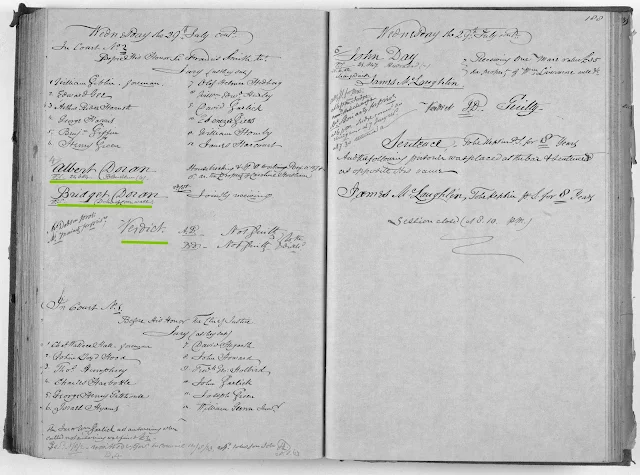
Larceny 1863 housebreaking with Bridget Doran
Link: https://libraries.tas.gov.au/Digital/SC32-1-8/SC32-1-8_223
106576 ALBERT DORAN MALE HOUSEBREAKING AND STEALING 1863-07-29 HOBART TOWN SMITH NOT GUILTY Link 1 and Link 2
106780 ALBERT DORAN MALE LARCENY 1864-06-01 HOBART TOWN SMITH DISCHARGED BY PROCLAMATION Link 1 and Link 2
Source: The Prosecution Project, Griffith University from Archives Office of Tasmania records
Link: https://app.prosecutionproject.griffith.edu.au/web/public-search/search
2. Miners in Crimean work shirts

Source: https://findlotsonline.com/auction-lot-details/769346/
BISHOP-OSBORNE, John [1851-1934] - Silver Miners near Zeehan, northwest Tasmania, circa 1891-94
Silver albumen print photograph, cabinet card format, 110 x 160mm; verso with photographer’s wet stamp.
Notes:A Hobart photographer, Bishop-Osborne was based at Zeehan between 1891 and 1894. Large deposits of silver-lead ore had been discovered in the area in 1882 and by 1893, 14,000 tonnes were being mined each year.
RELATED POSTS main weblog





